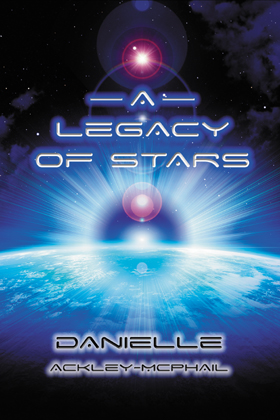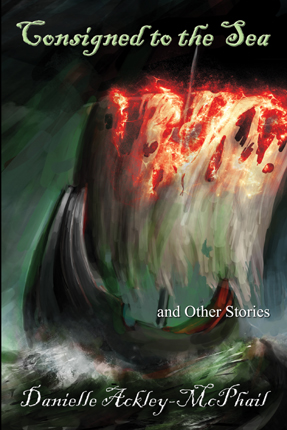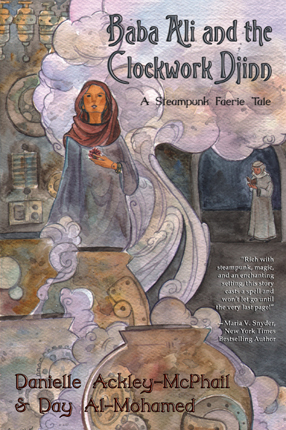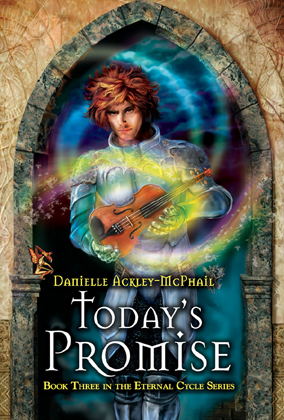Talking this week about Danielle’s science fiction stories, her oceanic fantasy tales, and her most recent novel, Baba Ali and the Clockwork Djinn, co-authored with Day Al Mohamed, and the fine art of authorial collaboration. (Read Part 1, Part 2, Part 3, or Part 4.)
 You also write science fiction, collected in A Legacy of Stars. How do you change gears from one genre to the other?
You also write science fiction, collected in A Legacy of Stars. How do you change gears from one genre to the other?
Basically? I have way too many ideas in my head. I get an idea and I follow it, it’s that simple. I read pretty much everything so I’m equally conversant with fantasy and science fiction. Beyond that, I love to play with ideas and to play what if. Whether the speculative element is magic or science it is still a challenge to make the improbable plausible. Also, no matter what I am writing it is virtually always character-driven. With the character being the most important element in the story, the rest is just a matter of how the character interacts with their world. With that approach it doesn’t really take much of a shift for me to go from magic to science.
Jean Paul Marot, a tragic character who appears in “By Any Means” and “Last Man Standing” in A Legacy of Stars has a bit of a cult following, even though you haven’t written that much about him yet. How did you come to create poor Jean, and do you plan to write anymore about him?
Oh, Jean-Paul…one of my favorite and most ill-fated characters. This is a case of a character introducing themselves. He first appeared in New Blood (Padwolf Publishing), a collection of stories about newly-turned vampires. When I was invited to the collection I asked the editor what they hadn’t received yet that they would have liked to have seen. The immediate response was science fiction. This is how Jean-Paul was born. I won’t go into the specifics since that would ruin the first story for anyone who hadn’t read it yet, but suffice it to say that these tales give a new perspective on humanity and the innate strength of man. I love Jean-Paul and I truly feel bad about what I’ve put him through, but you know… I think it’s always him because he is the strongest character I have. He is the best suited to come out the other end… eventually… even stronger yet. I am sure we will see him again as his tale is far from done, but I have to let my current idea simmer. Give Jean-Paul a chance to lick his wounds….
 Most recently you published a collection of seafaring fantasy tales, Consigned to the Sea, and a novel, Baba Ali and the Clockwork Djinn, co-authored with Day Al Mohamed. Tell us about these books. Do they intersect with any of your series?
Most recently you published a collection of seafaring fantasy tales, Consigned to the Sea, and a novel, Baba Ali and the Clockwork Djinn, co-authored with Day Al Mohamed. Tell us about these books. Do they intersect with any of your series?
Consigned to the Sea (Dark Quest Books) is a collection of my short fiction that has appeared in various anthologies over the years. The stories are either in a purely fantasy world, or they are historic fantasy so they don’t draw on any of my other works. Someday they might spawn novels of their own…but right now they are just fiction written to whatever theme I was challenged to write at the time. Several of the stories are set in established universes that I return to from time to time when I can find a way to connect those universes to a particular theme, but that is mostly to simplify things for myself because, as with serials, a lot of the groundwork is already in place so all I need concern myself with is the thread of the story.
Baba Ali and the Clockwork Djinn is something altogether different from anything I have ever done before. Originally it was meant to be a story for Gaslight and Grimm: Steampunk Faerie Tales (Dark Quest Books, Fall 2014) and I was consulting with Day Al-Mohamed to ensure I captured the proper regional and cultural flavor the tale called for. In the end we instead co-wrote the piece, and it quickly grew beyond the bounds of our expectations. This was my first successful collaboration and while challenging, it also brought richness to the project as we mingled ideas and perspectives to find the right balance of action and introspection for the story. When we drew the “short” story to a close—having glossed over many details out of necessity—it was a hefty 17,000 words. When the publisher learned how long it had gone, he declared it a book and told us to go finish it. We owe him a drink for that one. After we fleshed it out and did a proper job of covering all the relevant points we had a work we could truly be proud of that seems to speak to the reader on so many levels, if our advance reviews are anything to go by. We are very excited to unleash this book on the world and see where it takes us all. Already we have several ideas for continuations… not to mention a new story to write for Gaslight and Grimm. We’re going with Aladdin this time, and tying it into the same universe. What can I say… we’re having fun!
What a great example of a book taking on a life of its own. Tell us a bit about what Baba Ali and the Clockwork Djinn is all about.
This novel is a steampunk retelling of Ali Baba and the Forty Thieves, but it is so much more than that at the same time. We’ve drawn in the history and the culture of both Victorian England and the Middle East to immerse the reader in Ali’s world. In our version Ali is the son, not the father, though the rest of the core story remains pretty much the same.
As the second son, Ali is sent to England to apprentice with the famed Charles Babbage as an artificer. When he is in the middle of his apprenticeship a strange clockwork falcon delivers a puzzle box and a mystery others would kill to keep secret. Ali is unaware of this and only knows the box is magical and he has yet to find the key. When his father dies and his jealous brother summons Ali back to Arabia, danger follows him home.
Once Ali returns to the desert the tale—mostly—follows the same path as original, but in its own unique way.
This is a rich tale set against an exotic backdrop where the universe itself comes alive for the reader. No matter whether a person is familiar with the original or not, this novel will enchant with its melding of the magic and the mechanical.
 How did you and Day work together? What was the writing process like?
How did you and Day work together? What was the writing process like?
With a great deal of patience! Both of us have very take-charge personalities, our greatest challenge was in relinquishing some of that control we are both so used to having on a project. For Day this wasn’t as hard because she is used to working as a team on screenplays and comic, but for me it was my first time seriously collaborating with another author. There was never any tension between us, but I definitely had internal struggles when her creative vision didn’t match mine.
Our process mostly worked like this: One of us would write a scene and send it back to the other. That person would tweak what was there and add a little more. It would go back to the original person who would then accept or reject the revisions and then have to support why. We would use track changes to leave messages or clarifications for one another, or to question a particular decision we didn’t understand. At the same time as all of this was going on we had our alpha reader, Halla, reading sections as they were completed and she would call us on things as well. From time to time we would talk on the phone, in person, or via email and hash out particular plot points. The whole process was somewhat controlled chaos, but it worked for us!
Our individual creative inspiration, with a bit of input from Halla, really melded well together to create a lush, vibrant setting and characters with their own distinct and consistent voices. Justifiably we take pride in the fact that readers have been unable to identify segments of the text that were clearly written by one or the other of us.
Next Week: Danielle and I conclude our interview talking about what goes into making successful anthologies, the state of publishing today, navigating the wild trails of fandom and conventions, and what’s next for Danielle.
To follow Danielle’s projects, learn more about her, or buy her books, please check out her website and visit her Amazon author page. Also, look for her on the convention circuit where she’s a steadfast con presence up and down the east coast.

